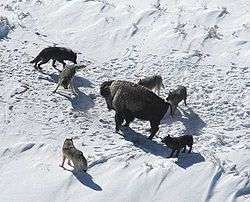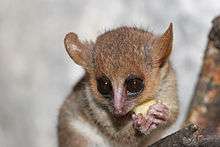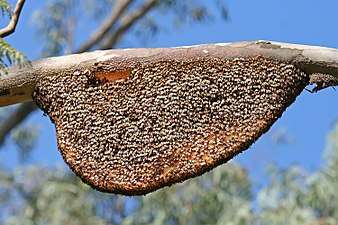Sociality
Sociality is the degree to which individuals in an animal population tend to associate in social groups (gregariousness) and form cooperative societies.
| Look up sociality in Wiktionary, the free dictionary. |

Sociality is a survival response to evolutionary pressures.[1] For example, when a mother wasp stays near her larvae in the nest, parasites are less likely to eat the larvae.[2] Biologists suspect that pressures from parasites and other predators selected this behavior in wasps of the family Vespidae.
This wasp behaviour evidences the most fundamental characteristic of animal sociality: parental investment. Parental investment is any expenditure of resources (time, energy, social capital) to benefit one's offspring. Parental investment detracts from a parent's capacity to invest in future reproduction and aid to kin (including other offspring). An animal that cares for its young but shows no other sociality traits is said to be subsocial.
An animal that exhibits a high degree of sociality is called a social animal. The highest degree of sociality recognized by sociobiologists is eusociality. A eusocial taxon is one that exhibits overlapping adult generations, reproductive division of labor, cooperative care of young, and—in the most refined cases—a biological caste system.
Presociality
Solitary animals such as the jaguar do not associate except for courtship and mating.[3] If an animal taxon shows a degree of sociality beyond courtship and mating, but lacks any of the characteristics of eusociality, it is said to be presocial.[4] Although presocial species are much more common than eusocial species, eusocial species have disproportionately large populations.[5]
The entomologist Charles D. Michener published a classification system for presociality in 1969, building on the earlier work of Suzanne Batra (who coined the words eusocial and quasisocial in 1966).[6][7] Michener used these terms in his study of bees, but also saw a need for additional classifications: subsocial, communal, and semisocial. In his use of these words, he did not generalize beyond insects. E. O. Wilson later refined Batra's definition of quasisocial.[8][9]
Subsociality
Subsociality is common in the animal kingdom. In subsocial taxa, parents care for their young for some length of time. Even if the period of care is very short, the animal is still described as subsocial. If adult animals associate with other adults, they are not called subsocial, but are ranked in some other classification according to their social behaviours. If occasionally associating or nesting with other adults is a taxon's most social behaviour, then members of those populations are said to be solitary but social. See Wilson (1971)[10] for definitions and further sub-classes of varieties of subsociality. Choe & Crespi (1997)[11] and Costa (2006)[12] give readable overviews.
Insect groups with subsocial species include:
- Dermaptera[13][14][15]
- Orthoptera
- Blattodea
- Zoraptera[16]
- Psocoptera[17]
- Embioptera[18][19]
- Hemiptera:[20][21] many families, including Membracidae,[22][23] Pentatomidae,[24] Reduviidae,[25][26][27] Tingidae.[28] Paternal care is known in some reduviids.[29]
- Thysanoptera
- Coleoptera.[30] Species and clades in multiple families:
- Erotylidae[31]
- Scarabaeidae[32][33]
- Silvanidae
- Tenebrionidae[34][35]
- Gyrinidae
- Passalidae;[36][37][38] the biology of Odontotaenius disjunctus (Illiger) is summarized by Bibbs et al.[39]
- Silphidae[40]
- Staphylinidae[41][42]
- Curculionidae
- Scolytinae[43][44][45][46]
- Platypodinae,[47][45]
- Other Curculionidae
- Chrysomelidae. In the leaf beetles, subsociality has been documented in two subfamilies, Cassidinae and Chrysomelinae.[48][49][50] In Cassidinae (43 tribes, 325 genera, c. 6000 species), maternal guarding of broods (eggs, larvae, pupae) is documented so far in two tribes (in the derived tortoise beetles clade[51]). In the Neotropical tribe Eugenysini, it appears in both Agenysa and Eugenysa.[52] In the tribe Mesomphaliini, subsocial species are documented in Acromis,[53] Omaspides, and Paraselenis. In Chrysomelinae (150 genera, c. 3000 species), maternal guarding of eggs and larvae is known in four tribes: Chrysomelini: Proseicela,[54] Doryphorini: Doryphora and Platyphora;[54] Gonioctenini: Gonioctena; and Phyllocharitini: Pterodunga mirabile in Australia.[55] See Chaboo et al. 2014 for a molecular-based phylogeny of Chrysomelinae and discussion of the origin of maternal care. Generally, reproductive and defence strategies in this subfamily are very diverse, with situations of ovoviviparity and viviparity and chemical defence.[56]
- Lepidoptera[57]
- Hymenoptera
Solitary but social

Solitary-but-social animals forage separately, but some individuals sleep in the same location or share nests. The home ranges of females usually overlap, whereas those of males do not. Males usually do not associate with other males, and male offspring are usually evicted upon maturity. Among primates, this form of social organization is most common among the nocturnal strepsirrhine species and tarsiers. Solitary-but-social species include mouse lemurs, lorises, and orangutans.[58]
Parasociality
Sociobiologists place communal, quasisocial, and semisocial animals into a meta-class: the parasocial. The two commonalities of parasocial taxa are the exhibition of parental investment, and socialization in a single, cooperative dwelling.[4]
Communal, quasisocial, and semisocial groups differ in a few ways. In a communal group, adults cohabit in a single nest site, but they each care for their own young. Quasisocial animals cohabit, but they also share the responsibilities of brood care. (This has been observed in some Hymenoptera and spider taxa,[59] as well as in some other invertebrates.)[4] A semisocial population has the features of communal and quasisocial populations, but they also have a biological caste system that delegates labor according to whether or not an individual is able to reproduce.
Beyond parasociality is eusociality. Eusocial insect societies have all the characteristics of a semisocial one, except overlapping generations of adults cohabit and share in the care of young. This means that more than one adult generation is alive at the same time, and that the older generations also care for the newest offspring.
Eusociality

Eusocial societies have overlapping adult generations, cooperative care of young, and division of reproductive labor. When organisms in a species are born with physical characteristics specific to a caste which never changes throughout their lives, this exemplifies the highest acknowledged degree of sociality. Eusociality has evolved in several orders of insects. Common examples of eusociality are from Hymenoptera (ants, bees, sawflies, and wasps) and Blattodea (infraorder Isoptera, termites), but some Coleoptera (such as the beetle Austroplatypus incompertus), Hemiptera (bugs such as Pemphigus spyrothecae), and Thysanoptera (thrips) are described as eusocial. Eusocial species that lack this criterion of morphological caste differentiation are said to be primitively eusocial.[4]
Two potential examples of primitively eusocial mammals are the naked mole-rat and the Damaraland mole-rat (Heterocephalus glaber and Fukomys damarensis, respectively).[60] Both species are diploid and highly inbred, and they aid in raising their siblings and relatives, all of whom are born from a single reproductive queen. They usually live in harsh or limiting environments. However, a study conducted by O'Riain and Faulkes in 2008 suggests that due to regular inbreeding avoidance, mole rats sometimes outbreed and establish new colonies when resources are sufficient.[61]
Eusociality has arisen among some crustaceans that live in groups in a restricted area. Synalpheus regalis are snapping shrimp that rely on fortress defense. They live in groups of closely related individuals, amidst tropical reefs and sponges.[62] Each group has one breeding female; she is protected by a large number of male defenders who are armed with enlarged snapping claws. As with other eusocial societies, there is a single shared living space for the colony members, and the non-breeding members act to defend it.[63]
Human eusociality
E. O. Wilson and Bert Hölldobler controversially[64] claimed in 2005 that humans exhibit sufficient sociality to be counted as a eusocial species, and that this enabled them to enjoy spectacular ecological success and dominance over ecological competitors.[65]
See also
References
- Smelser, Neil J.; Baltes, Paul B., eds. (2001). "Evolution of Sociality". International Encyclopedia of the Social & Behavioral Sciences. New York: Elsevier. p. 14506. ISBN 9780080430768. OCLC 47869490.
- Ross, Kenneth G.; Matthews, Robert W. (1991). The Social Biology of Wasps. Ithaca: Comstock Publishing Associates. ISBN 9780801420351. OCLC 22184337.
- Cavalcanti, Sandra M. C.; Gese, Eric M. (14 August 2009). "Spatial Ecology and Social Interactions of Jaguars (Panthera Onca) in the Southern Pantanal, Brazil". Journal of Mammalogy. Oxford University Press (OUP). 90 (4): 935–945. doi:10.1644/08-mamm-a-188.1.
- Gadagkar, Raghavendra (September 1987). "What are social insects?" (PDF). IUSSI Indian Chapter Newsletter. 1 (2). Archived from the original (PDF) on 2012-01-05. Retrieved 2013-12-12.
- Nowak, Martin A.; Tamita, Corina E.; Wilson, Edward O. (2010). "The Evolution of Eusociality". Nature. 466 (7310): 1057–1062. doi:10.1038/nature09205. PMC 3279739. PMID 20740005.
- Michener, C. D. (1969). "Comparative Social Behavior of Bees". Annual Review of Entomology. 14: 299–342. doi:10.1146/annurev.en.14.010169.001503.
- Batra, S. W. T. (1966). "Social behavior and nests of some nomiine bees in India (Hymenoptera, Halictidæ)". Insectes Sociaux. 13 (3): 145–153. doi:10.1007/BF02223020.
- Wilson, E. O. (1971). The Insect Societies. Cambridge: Belknap Press. ISBN 9780674454903. OCLC 199513.
- Capinera, John L., ed. (2008). "Eusocial Behavior". Encyclopedia of Entomology. Springer. pp. 1377–1378. doi:10.1007/978-1-4020-6359-6_3698. ISBN 978-1-4020-6242-1. Entry is linked to entries on each of the other terms, as Subsocial, Quasisocial, etc.
- Wilson, E. O. (1971). The Insect Societies. Cambridge: Belknap Press. ISBN 9780674454903. OCLC 199513.
- Choe, J.C. & B.J. Crespi. 1997. [Eds.] The evolution of Social Behavior in Insects and Arachnids. Cambridge: Cambridge University Press.
- Costa JT. 2006. The other insect societies. Belknap: Harvard University Press.
- Beier, M. 1959. Ordung Dermaptera (De Geer 1773) Kirby 1913. In: Weber, H. (Ed.), Bronn's Klassen und Ordnungen des Tierreichs (Dermaptera), Vol. V(part III), pp. 455-585. Leipzig: Akademische Verlagsgesellschaft
- Radl RC, Linsenmair KE. 1991. Maternal behaviour and nest recognition in the subsocial earwig Labidura riparia Pallas (Dermaptera: Labiduridae). Ethology. 89:287–296.
- Rankin SM, Storm SK, Pieto DL, Risser AL. 1996. Maternal behavior and clutch manipulation in the ring-legged earwig (Dermaptera: Carcinophoridae). J Ins Behav. 9:85–103.
- Choe, J.C. 1997. The evolution of mating systems in the Zoraptera: mating variations and sexual conflicts. pp. 130-145. In: Choe, J.C. & B.J. Crespi. 1997. [Eds.] The evolution of Social Behavior in Insects and Arachnids. Cambridge: Cambridge University Press.
- Costa JT. 2006. Chpt. 8. Psocoptera and Zoraptera. The other insect societies. Belknap: Harvard University Press.
- Edgerley, J.S. 1997. Life beneath silk walls: a review of the primitively social Embiidina. pp. 14-25. In: Choe, J.C. & B.J. Crespi. 1997. [Eds.] The evolution of Social Behavior in Insects and Arachnids. Cambridge: Cambridge University Press.
- see works of Janice Edgerly-Rooks, https://www.scu.edu/cas/biology/faculty/edgerly-rooks/
- Tallamy, D.W. and C. Schaeffer. 1991. Maternal care in the Hemiptera: ancestry, alternatives, and current adaptive value. pp. 94-115. In: Choe, J.C. & B.J. Crespi. 1997. [Eds.] The evolution of Social Behavior in Insects and Arachnids. Cambridge: Cambridge University Press.
- Tallamy DW, Wood TK. 1986. Convergence patterns in subsocial insects. Ann Rev Entomol.31:369–390.
- Cocroft RB. 1999. Parent-offspring communication in response to predators in a subsocial treehopper (Hemiptera: Membracidae: Umbonia crassicornis). Ethology. 105:553–568.
- Cocroft RB. 2002. Antipredator defense as a limited resource: unequal predation risk in broods of an insect with maternal care. Behav Ecol. 13:125–133.
- Eberhard WG. 1975. The ecology and behavior of a subsocial pentatomid bug and two scelionid wasps: strategy and counter-strategy in a host and its parasites. Smithson Contrib Zool. 205:1–39. doi:10.5479/si.00810282.205
- Odhiambo TR. 1959. An account of parental care in Rhinocoris albopilosus Signoret (Hemiptera-Heteroptera: Reduviidae), with notes on its life history. Proc Roy Entomol Soc. Lond A. 34:175–185.
- Odhiambo TR. 1960. Parental care in bugs and non-social insects. New Sci. 8:449–451.
- see works by Forero, https://sites.google.com/a/cornell.edu/dimitriforero/publications
- Tallamy DW. 1982. Age specific maternal defence in Gargaphia solani (Hemiptera: Tingidae). Behav Ecol Sociobiol. 11:7–11.
- Tallamy, D.W., E. Walsh, and D.C.Peck. 2004. Revisiting Paternal Care in the Assassin Bug, Atopozelus pallens (Heteroptera: Reduviidae). Journal of Insect Behavior, Vol. 17, No. 4: 431-436.
- Brandmayr P. 1992. Short review of the presocial evolution in Coleoptera. Ethol Ecol Evol. 4:7–16.
- Chaboo CS, McHugh JV. 2010. Maternal care by a species of Pselaphacus Percheron (Coleoptera: Erotylidae: Erotylinae) from Peru. Coleop Bull. 64:116–118.
- Klemperer HG. 1983. The evolution of parental behaviour in Scarabaeinae (Coleoptera, Scarabaeidae): an experimental approach. Ecol Entomol. 8:49–59.
- Halffter, G. 1991. Subsocial behavior in Scarabaeinae beetles. pp. 237-259. In: Choe, J.C. & B.J. Crespi. 1997. [Eds.] The evolution of Social Behavior in Insects and Arachnids. Cambridge: Cambridge University Press.
- Iwan D. 2000. Ovoviviparity in tenebrionid beetles of the melanocratoid Platynotina (Coleoptera: Tenebrionidae: Platynotini) from Madagascar, with notes on the viviparous beetles. Ann Zool. 50:15–25.
- Rasa OAE. 1990. Interspecific defence aggregations: a model for the evolution of sociality and kin selection. Neth J Zool. 40:711–728.
- Schuster JC, Schuster LB. 1985. Social behavior in passalid beetles (Coleoptera: Passalidae): cooperative broode care. Florida Entomologist 68: 266-272.
- Valenzuela-Gonzalez JV. 1992. Pupal cell-building behavior in passalid beetles (Coleoptera: Passalidae). Journal of Insect Behavior 6: 33-41
- Wicknick JA, Miskelly SA. 2009. Behavioral interactions between non-cohabitating bess beetles, Odontotaenius disjunctus (Illiger) (Coleoptera: Passalidae). The Coleopterists Bulletin 63: 108-116.
- "Horned passalus - Odontotaenius disjunctus (Illiger)".
- Trumbo ST. 1994. Interspecific competition, brood parasitism, and the evolution of biparental cooperation in burying beetles. Oikos. 69:241–249.
- Wyatt TD. 1986. How a subsocial intertidal beetle, Bledius spectabilis, prevents flooding and anoxia in its burrow. Behav Ecol Sociobiol. 19:323–331.
- Hinton HE. 1944. Some general remarks on sub-social beetles, with notes on the biology of the staphylinid, Platystethus arenarius (Fourcroy). Proc Roy Entomol Soc Lond A. 19:115–128.
- K.F. Raffa, J.-C. Gregoire B., and S. Lindgren (2015) Natural history and ecology of bark beetles. [pp. 1–28] In: Bark Beetles - Biology and Ecology of Native and Invasive Species (F.E. Vega & R.W. Hofstetter, eds,). Academic Press, Cambridge, MA.
- Reid ML, Roitberg BF. 1994. Benefits of prolonged male residence with mates and brood in pine engravers (Coleoptera: Scolytidae). Oikos. 70:140–148.
- Kirkendall, L.R., P.H.W. Biedermann, and B.H. Jordal. 2015. Evolution and diversity of bark and ambrosia beetles. [pp. 85–156]. In: Bark Beetles - Biology and Ecology of Native and Invasive Species (F.E. Vega & R.W. Hofstetter, eds,). Academic Press, Cambridge, MA.
- Aaron S. Weed, Matthew P. Ayres, and Barbara J. Bentz. 2015 Population Dynamics of Bark Beetles.
- Kirkendall, L.R., D.S. Kent, and K.F. Raffa. 1997. Interactions among males, females and offspring in bark and ambrosia beetles: the significance of living in tunnels for the evolution of social behavior [pp. 181–215]. In: The Evolution of Social Behavior in Insects and Arachnids (J.C. Choe and B.J. Crespi, eds.). Cambridge University Press, Cambridge, UK.
- Windsor DM, Choe JC. 1994. Origins of parental care in chrysomelid beetles. In: Jolivet PH, Cox ML, Petitipierre E, editors. Novel aspects of the biology of Chrysomelidae. Series Entomologica 50. Dordrecht: Kluwer Academic Publishers; p. 111–117.
- Chaboo, C.S., F.A. Frieiro-Costa, J. Gómez-Zurita, R. Westerduijn. 2014. Subsociality in leaf beetles (Coleoptera: Chrysomelidae: Cassidinae, Chrysomelinae). Journal of Natural History 48:1–44.
- see works of Caroline Chaboo, http://www.leafbeetles.org/
- Chaboo CS. 2007. Biology and phylogeny of the Cassidinae Gyllenhal sensu lato (tortoise and leaf-mining beetles) (Coleoptera: Chrysomelidae). Bull Amer Mus Nat Hist. 305:1–250.
- Chaboo CS. 2002. First report of immatures, genitalia and maternal care in Eugenysa columbiana (Boheman) (Coleoptera: Chrysomelidae: Cassidinae: Eugenysini). Coleop Bull. 56:50–67.
- Windsor DM. 1987. Natural History of a Subsocial Tortoise Beetle, Acromis sparsa Boheman (Chrysomelidae, Cassidinae) in Panama. Psyche J Entomol. 94:127–150.
- Chaboo, Caroline S., Andreas Kay, and Rob Westerduijn. 2019. New Reports of Subsocial Species of Proseicela Chevrolat and Platyphora Gistel (Coleoptera: Chrysomelidae: Chrysomelinae: Chrysomelini). The Coleopterists Bulletin 73(3):710-713.
- Reid CAM, Beatson M, Hasenpusch J. 2009. The morphology and biology of Pterodunga mirabile Daccordi, an unusual subsocial chrysomeline (Coleoptera: Chrysomelidae). J Nat Hist. 43):373–398.
- Plasman V, Plehiers M, Braekman JC, Daloze D, de Biseau JC, Pasteels JM. 2001. Chemical defence in Platyphora kollari Baly and Leptinotarsa behrensi Harold (Coleoptera: Chrysomelidae). Hypotheses on the origin and evolution of leaf beetles toxins. Chemoecology. 11:107–112.
- Costa, J.T. and N.E. Pierce. 1991. Social evolution in the Lepidoptera: ecological context and communication in larval societies. pp. 407-442. In: Choe, J.C. & B.J. Crespi. 1997. [Eds.] The evolution of Social Behavior in Insects and Arachnids. Cambridge: Cambridge University Press.
- Sussman, R. W. (2003). "Ecology: General Principles". Primate Ecology and Social Structure. Pearson Custom Publishing. p. 29. ISBN 978-0-536-74363-3. OCLC 57408633.
- Furey, R. E. (1998). "Two cooperatively social populations of the theridiid spider Anelosimus studiosus in a temperate region". Animal Behaviour. 55 (3): 727–735. doi:10.1006/anbe.1997.0648. PMID 9515053.
- Burda, H. Honeycutt; Begall, S.; Locker-Grutjen, O; Scharff, A. (2000). "Are naked and common mole-rats eusocial and if so, why?". Behavioral Ecology and Sociobiology. 47 (5): 293–303. doi:10.1007/s002650050669.
- O'Riain, M. J.; Faulkes, C. G. (2008). "African Mole-Rats: Eusociality, Relatedness and Ecological Constraints". Ecology of Social Evolution. Springer. pp. 207–223. doi:10.1007/978-3-540-75957-7_10. ISBN 978-3-540-75956-0.
- Duffy, J. Emmett; Cheryl L. Morrison; Ruben Rios (2000). "Multiple origins of eusociality among sponge-dwelling shrimps (Synalpheus)". Evolution. 54 (2): 503–516. doi:10.1111/j.0014-3820.2000.tb00053.x. PMID 10937227.
- J. Emmett Duffy (1998). "On the frequency of eusociality in snapping shrimps (Decapoda: Alpheidae), with description of a second eusocial species". Bulletin of Marine Science. 63 (2): 387–400.
- Angier, Natalie (2012). "Edward O. Wilson's New Take on Human Nature". Smithsonian Magazine (April 2012). Retrieved 19 December 2016.
- Wilson, E. O.; Hölldobler, Bert (2005). "Eusociality: Origin and consequences". PNAS. 102 (38): 13367–13371. doi:10.1073/pnas.0505858102. PMC 1224642. PMID 16157878.